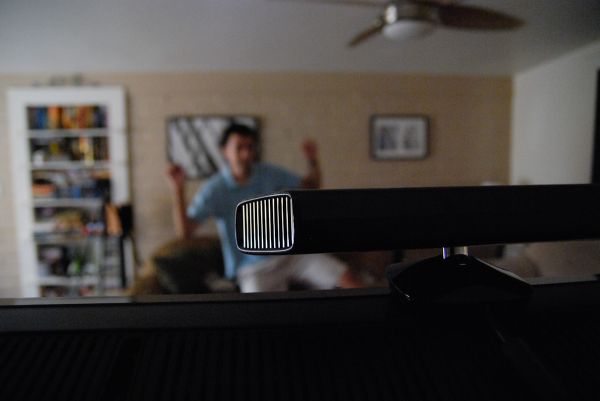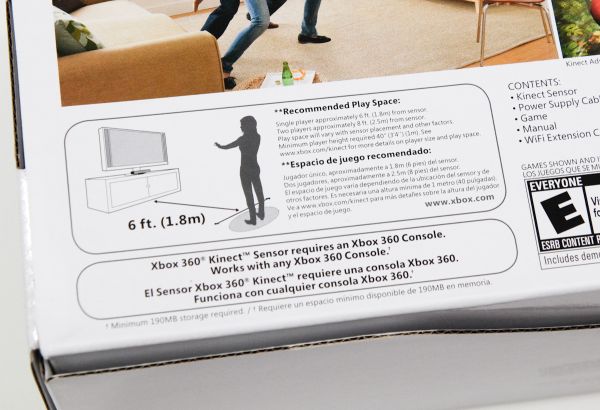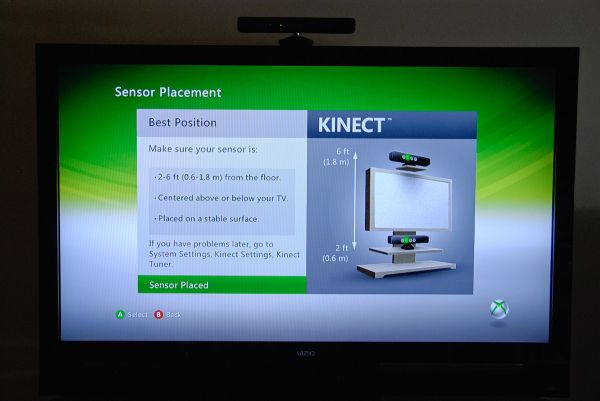Microsoft Kinect: The AnandTech Review
by Brian Klug on December 9, 2010 3:20 PM ESTKinect - Environmental Constraints
There are a lot of environmental constrains that the Kinect imposes, but the system actually works extremely well. Inside the manual and throughout the literature distributed with Kinect are notices about reducing ambient sunlight in the room you’re using the Kinect. At the same time, you need ambient light for the RGB color camera to work - this seems somewhat confusing until you consider that sunlight also contains spectral components at the same wavelength the Kinect operates at. Lots of ambient sunlight thus decreases the visibility of those spots on the room and players, and could conceivably make depth detection much worse. That sort of reminds me how the Wii sensor bar could be emulated with candles some distance apart atop the television, or how playing with the Wii next to a fireplace could easily make the system glitch out.
In practice, I never once noticed problems with depth detection on Kinect that I’d blame on ambient noise from stray light sources - even in a room with, yes, a huge fireplace (hey, it’s a reasonable test). The more important consideration actually turns out to be the relatively poor sensitivity of the RGB camera, which requires lots of room lighting to get decent framerate or augment facial detection.
The more important consideration for playing space is play space size - you need a big room to use Kinect. On the back of the Kinect packaging, Microsoft notes that a distance of 6’ from TV to players is requisite at minimum. After a lot of testing, I’d say 6’ is optimistic, even for one person. In actuality I’d say 9’-12’ is closer to what is optimal, especially if you want to play with a second person, and later inside games you’ll be told as much.
Sensor position itself makes a lot of difference here - Kinect can go either on top or below the TV, and Microsoft recommends anywhere 2’ - 6’ off the ground. Ultimately, the bar is that Kinect needs to be able to see your entire person - feet, head, and some distance around you to move, jump, and flail your arms around inside. If you place the Kinect on an entertainment center table below the TV, the hazard is that the depth of the table will block part of the depth image at the bottom. I had much more success with placing the Kinect atop TVs, especially when you encounter LCDs and pasmas of the wall-mounted sort.
The first area I tested was my living room, which is reasonably large (or so I used to think), and I played with about 7 feet away from the sensor. I moved a coffee table, unfortunately moving my couch is prohibitively difficult, and I didn’t have space to get rid of it. I was able to play with two people, but it was a bit cramped, and I felt like I needed more distance from the TV the whole time.
 See that above me? Yeah, it's a ceiling fan.
See that above me? Yeah, it's a ceiling fan.
The consideration I didn’t think of is what’s above. Needless to say, you need space to flail your arms around, especially if you’re tall. Above me within arm’s reach is a ceiling fan. That’s a serious problem if you get excited and jump with your arms above your head, as my girlfriend experienced a few minutes into our first session of Kinect Adventures. Ultimately, I can’t blame Kinect for my living room being small, but you need to be aware of the space constraints - Kinect won’t work in dorm rooms or tiny play areas, but does work with at least average sized living rooms. It’s entirely constrained by the field of view of the sensor and CGH, and admittedly it’s hard to make very wide angle CGH systems with good uniformity and repeatability.
I later tried Kinect in a much larger space with more than 12’ of space behind a wall-mounted plasma, with the Kinect mounted atop the display about 6.5’ above the ground. I had much more success here both with detection of my feet, and two-player space.
If you’re running out of space or are playing with just barely enough, the problems that arise are what you’d expect. Kinect won’t see your feet very well, or miss your hands, but thankfully most of the time you’re given feedback visually on the display that you need to move back into the optimal position.
The interesting bit of the Kinect space story is that closer to the sensor, you get better depth resolution at the cost of having less space to work in, yet far away you sacrifice depth resolution for more working area. It’s a simple consequence of field of view and the angular separation of those points in the CGH image. Prime Sense advertises that their reference design has a depth resolution of 1 cm at two meters from the sensor. As you move further away, that depth resolution gets worse (larger).
The final note is that I’ve actually noticed that clothing choice makes a difference. In fact, there are a few warnings in the literature shipped with games which notes that some clothing choices may make detection hard. I never had serious issues being detected outside of one special combination of cargo shorts and a specific footwork-heavy move in Dance Central, but more on that later. Common sense applies here, and essentially you need to look human and have some depth contrast visible for Kinect to detect your limbs.













72 Comments
View All Comments
brundleflyguy - Friday, December 10, 2010 - link
"My guess is, if you are using a projector, you should put Kinect in front of you... if there is enough cable length."Yeah, I know. :)
My current set up is:
Wall<--4ft-->WiiBar<---6ft--->Me<---4ft--->Wii<--1ft-->Projector.
I can't get much closer to the wall or my shadow blocks the projected image. My question is: If I replace the WiiBar and the Wii with the Kinect and XBox360 (respectively) would that work? Or would I be too close/far away from some component? I know I can get an active USB cable to reach from the XBox360 to the Kinect.
JonathanYoung - Friday, December 10, 2010 - link
I think I used up my quota for seeing the word "itself" in an article.brshoemak - Friday, December 10, 2010 - link
Totally OT, but I loved the pictures last.fm showed for Xzibit - we just need active content to rotate 'yo dawg' taglines over it.GTVic - Friday, December 10, 2010 - link
I shall now title all of my comments with my name.melgross - Friday, December 10, 2010 - link
I don't have an XBox and aren't interested in getting one, so I'm no XBox fanboy. But, for all those complaining about various problems, just remember that this is a 1st generation product. It's the first device of its type in the consumer market. It's got its problems, but it does a credible job. A year or two from now, either MS, or Sony, or Nintendo, or Apple will come out with a new one that works much better, as always happens. But this seems pretty good for what it is in this timespace.Portablenuke - Friday, December 10, 2010 - link
Forget the Kinect, where can I get wafer mask coasters!?trip1ex - Friday, December 10, 2010 - link
I think the reviewer was a little too generous.First he's too hung up on the fact you can cheat on the Wii. SEems to be his basis for liking Kinect.
I don't think he called out Kinect enough on its drawbacks or the quality of some of the games.
See what the reviewer failed to mention is how sloppy many of the games are.
Take Kinect Adventures.
YOu have to jump way before you think you have to in one of the games. Pretty darn laggy. And there's jaggedy jumping animation as well.
Waving your arms to hit balls in another game was just so un precise. You basically swing in the ballpark and you connect. It doesn't leave you with a solid precise feeling. You don't feel connected to what is happening on the screen. There's something missing between your actions and what happens on the screen.
It's the same with plugging wiki-leaks in Kinect Adventures. You see where the leak is and even though KInect tracks your hand/arm fairly accurately you're still just reaching in the dark to plug the Wiki-leak. There is no preciseness or feedback to the gameplay. OH this leak is down here somewhere I will just move my hand down there in the general vicinity until the screen shows the hole is plugged.
The only thing I found Kinect did really well in Kinect Adventures was track me as I moved left and right to avoid obstacles in the "moving platform" game. That was the only solid part.
Overall I found the KA and the integration of Kinect into the dashboard along with the voice commands and hand gestures to be pretty sloppy. I think that after the xmas gold rush wears off this device is going to die out pretty quickly unless someone comes out with a killer app.
DanaG - Friday, December 10, 2010 - link
Is there any way to put the XBox 360 in a sort of "kiosk" mode, where the only way to exit games would be to push a button somewhere? I see online that there's some "kiosk mode" disk, but I have no idea what other features it would disable, and that kiosk mode is supposedly irreversible.DanaG - Friday, December 10, 2010 - link
I'd be interested to see how much of that latency is caused by the receiver and the TV. I've seen some TVs where even a computer mouse is laggy enough to notice even with game mode (that disabled itself every time you turned off the TV); I had to switch back from HDMI to VGA on that device.Please try connecting the 360's HDMI to a known low-latency monitor that can do 720 or 1080.
clasam - Saturday, December 11, 2010 - link
Could we get an update about the lag WITHOUT the Onkyo ? Thx!